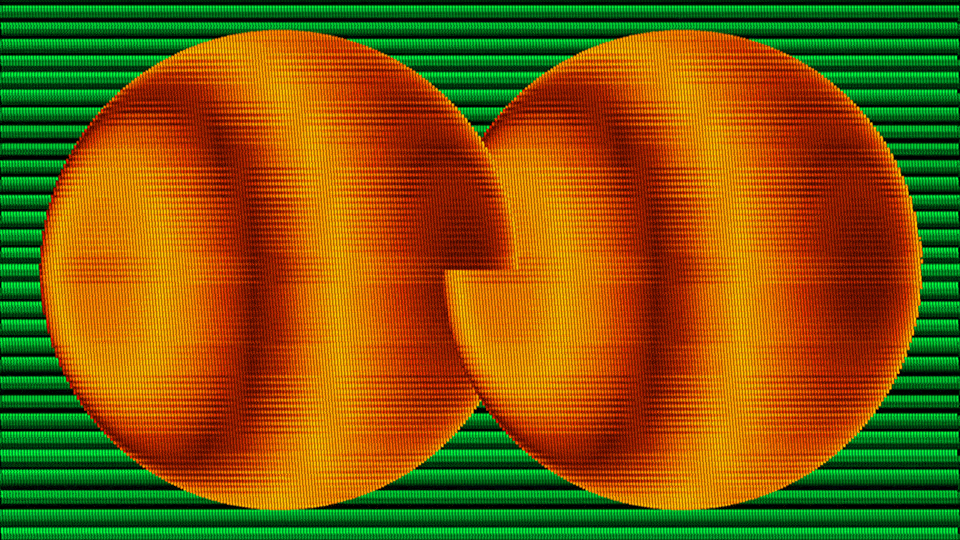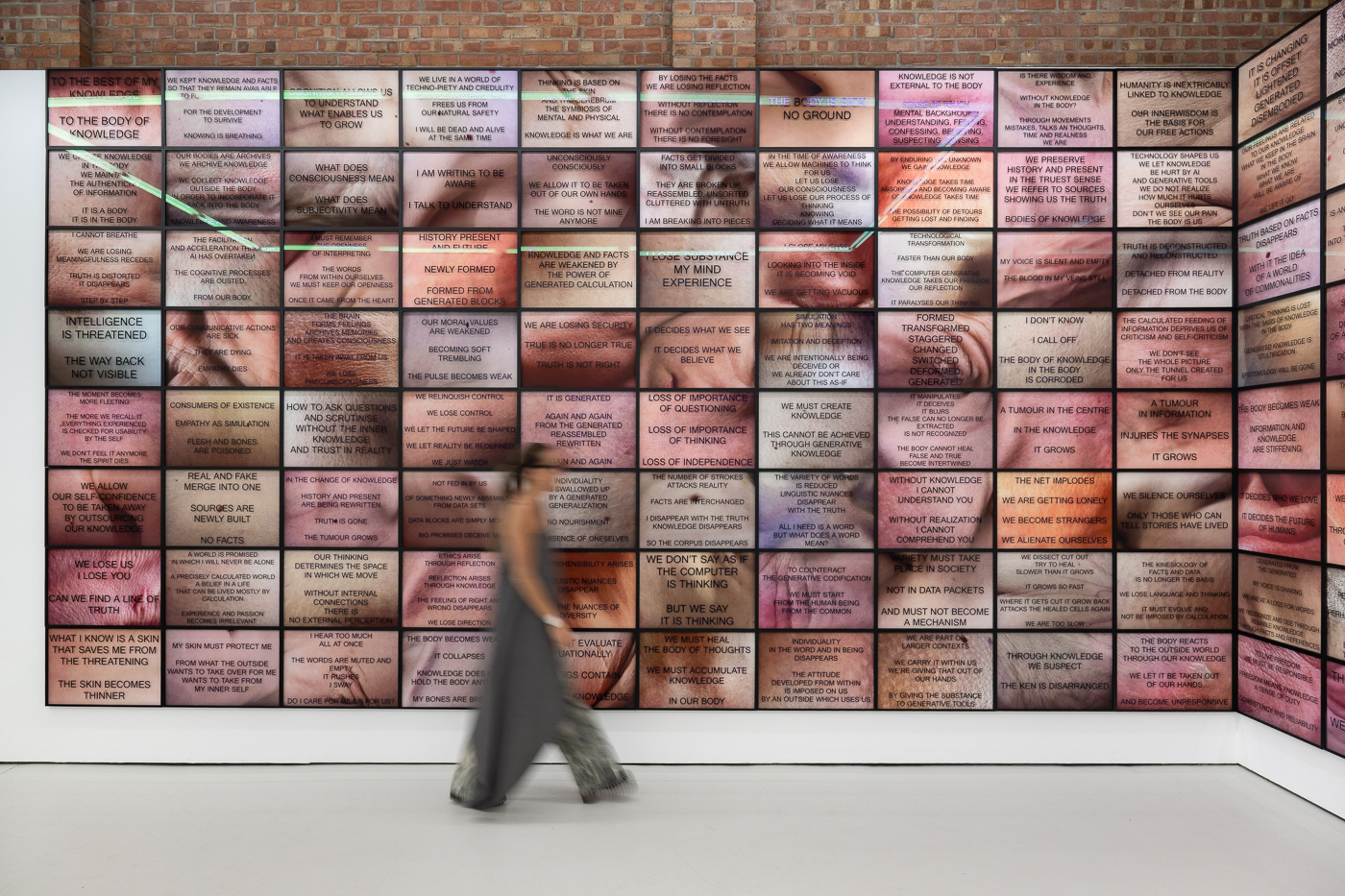
PRESS RELEASE INTERVIEW ARTIST INFORMATION PRINTS ALL ARTISTS
NICOLAS SASSOON |
EMBRACE
15 DECEMBER 2024 — ONGOING
EMBRACE
2023
Digital animation (colour, no sound), MP4 (digital moire pattern, post processing with Photoshop, animated GIF, uncompressed .mov), 72 frames (seamless loop)
0 min 32 sec
3840 x 2160px
Edition 1 of 1
(NSas001.23)
GBP 5,000 (exc. VAT)
PRESS RELEASE
ANNKA KULTYS GALLERY is pleased to present EMBRACE (2023), a digital animation by French Vancouver—based artist Nicolas Sassoon, in which the artist employs abstract animation to investigate the interplay between motion, perception, and optical phenomena. The work features two interlocked orange circular forms, their surfaces animated by shifting moiré patterns, suspended against a softly pulsating green background. This presentation is part of Illuminated: Moving Image Perspectives, the gallery digital programme, which will take place over the course of a year, and offer unique insights into new media artists using film, video animation, as well as their latest technological explorations, including blockchain and advanced technologies such as AI.
Nicolas Sassoon’s abstract animation EMBRACE, presents two shifting moiré patterned interlocked circular orange forms floating in space against a gently pulsating green background. The work generates subtle optical effects through a constant state of flow, the smooth liquid motion of the moiré interference patterns creating a sensation of vibration in the eye and a mesmeric effect on the viewer.
Using digital tools Sassoon has been developing for 15 years, EMBRACE continues the Modernist play with the relationship between the abstract, the illusionistic motion and the real. Experimentation with form led to the invention of abstraction, an exploration of concepts such as motion and duration resulted in the Kinetic, Op Art and video art movements, and an emphasis on new techniques, processes and materials eventually led to the use of the computer in art. In particular, EMBRACE references Op Art, reimagining Victor Vasarely’s belief that, “Optical art represents a state of transition from the conditions of discreet visibility to the conditions of continuous visibility.”
EMBRACE is rendered with a deliberately limited palette (green, black and orange), which gives a hint of vintage 1980s computer graphics. This is also a reminder of the artist’s childhood Atari video games wherein he invented imaginary worlds to escape into — as he says, “where the space of the screen becomes a two-dimensional portal leading into multi-dimensional universes.” Rather than an attempt to depict an external, recognisable reality, EMBRACE is a non-objective work using basic circular shapes, primary colours, and moiré patterns movement to communicate an existence purely as an idea in the mind. Ultimately this abstract artwork becomes a site for the eye to contemplate and the imagination to expand.
Over a 12-month period, Illuminated: Moving Image Perspectives will present a new artist online each week, offering a dynamic platform for contemporary moving image practices (weekly updates running from 17 November 2024 to 16 November 2025). To date, the featured artists include Jonas Lund, Sara Sadik, Oliver Laric, and Lauren Lee McCarthy with forthcoming contributions from Aram Bartholl, Tamiko Thiel and Che-Yu Hsu.
The online streams will be augmented by physical presentations of digital artworks in a private home setting at the gallery founder’s loft in Shoreditch. These installations will be accompanied by regular, invitation-only dinners and carefully curated exclusive viewings for art professionals, fostering deeper connections between artists, collectors, journalists, and museum curators.
Subsequently the artworks will be featured in a group exhibition at ANNKA KULTYS PHYGITAL. This VR group show will open end of May 2025 to coincide with London Gallery Weekend, highlighting contributions from 26 artists as part of this year-long initiative, then the second part of the VR with the other 26 artists in November 2025
As part of this initiative, prints of video stills by the artists will be made available for purchase on the gallery’s website. Furthermore, the gallery is pleased to announce a monthly giveaway, offering subscribers the opportunity to win a selected artist print. Each giveaway will be introduced in the monthly Full Moon newsletter, with the winner announced in the subsequent edition (next scheduled for 13 January 2025).
INTERVIEW

Can you walk us through your creative process for your work?
I work primarily with Photoshop, Animate, HTML, and 3D programs to create my digital work, which then extends into other mediums such as print, sculpture, installation, textiles, etc. The tools I use are comparable to analogue tools—drawing, animating, frame-by-frame—but within a digital workflow. Experimentation is an important part of my process: I record and organize my visual experiments, archive them, and use them in future work. When starting a new project, I begin by doing image research that is related to the themes of the artwork; I also draw on my previous work. I work through series, or create multiple versions of the same artwork, using different color palettes, compositions, motions, and speeds. All of this helps me to find the best version(s) of the work.
How do you see your work fitting into the evolving landscape of digital art?
My work employs a very specific visual language informed by early computer graphics from the 1980s, when the first home computers and videogame systems became mass marketed. I’m interested in these screen-based graphics for their optical qualities in relation to the screen, as well as their poetics, namely how expressive they are through minimal visual information. As much as my practice is rooted in histories of digital culture and digital craft, it is also inspired by other artistic traditions and legacies, such as the decorative arts, landscape painting, optical art, and net art. I’m always looking for connections between digital and traditional art forms; it grounds and contextualizes what I do.
How do you see the relationship between traditional art forms and digital media evolving in the future?
I believe these forms are much more intertwined than we tend to think of them. In my work, I use 3D modelling for sculptures, digital imaging for printing, and augmented reality for physical objects: there is already a great fluidity between analogue and digital forms. Within the digital realm, the visual language I use is already considered as “old media”, I also constantly refer to traditional art forms in my digital practice. The definitions of digital and traditional are always changing: if you talk to younger audiences for example, they don’t use the same criteria as previous ones when it comes to these categories.
If you could choose one technological invention from the past or future, what would it be and why?
I’m interested in art-related technological inventions, so for me, it would be video projection. It’s my favorite medium and I often use projections to create immersive environments. It’s a great way to create playful interventions in space such as adding imaginary layers of architecture (doors, windows, added structures) in a specific setting. Projection is technological but it is also just a light source projecting shapes, colors and shadows in a dark space, it is about our visceral relationship to light as a medium, which is as old as cave paintings. I find technology most exciting when it creates such a space of play, imagination, and reflection.
ARTIST INFORMATION
Nicolas Sassoon was born in 1981 in Marseille, France and now lives and works in Vancouver, Canada.



